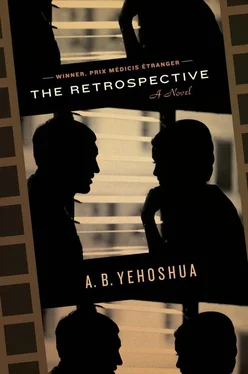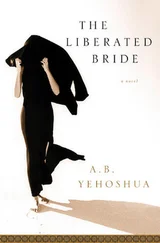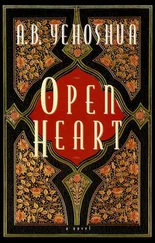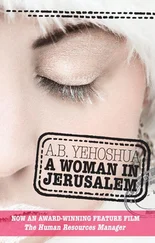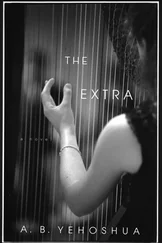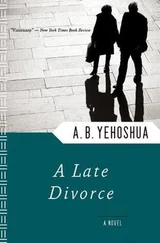Manuel translates rapidly, with great enthusiasm, apparently enjoying the opportunity to show off the Hebrew he learned in the order. Moses is so swept up in his introduction that it seems there will be no time left to show the film.
“To construct a plot, you have to choose a protagonist. Of course, it was possible to put the beadle of the synagogue at the center of the film, because it is he, more than anyone else, who maintains regular contact with the animal, especially at night when the animal is active and the synagogue is empty. But to render the story more meaningful, we preferred to make the rabbi the main character. We imagined a rabbi who had arrived in Israel with his flock from a distant Muslim land and established a synagogue where they could combine the old and the new. Then it turns out that a little animal, old and stubborn, had got there first, and its hideout is so ingenious that only if they destroy the building and put up a new one can they get rid of it. This, in short, is the issue: Do they destroy the synagogue, which was created with great effort and whose congregation may have scattered by the time it is rebuilt, or do they try to discover, in the sad, absurdist spirit of Kafka, some sort of coexistence between the worshippers and the animal? This is the heart of the matter, and I think I’ve already run on too long.”
He tries to disappear into the audience before the translation is over, but the hoarse voice of the theoretician stops him, adding a detail that perhaps escaped the filmmakers and that Kafka himself was probably unaware of. In ancient Egypt, the mongoose was considered a noble and holy animal, perhaps owing to its ability to trap and kill poisonous snakes. It was therefore entitled to be embalmed along with the Pharaonic families.
Moses is delighted. “Thank you, thank you. We didn’t know about ancient Egypt, and perhaps Kafka didn’t either. In any case, the historical dimension you have added to the animal can only deepen the understanding of our complex film.” And he motions to the projectionist to start the screening.
3
MOSES TRIES IN vain to recall the name, or at least the provenance, of the actor who played the rabbi in the film. He doesn’t appear in the credits because he had refused to have his name listed; during production, the animal was filmed separately and inserted in the editing room, and when the actor saw the final picture, with the full dialogue between him and the animal — whose role in the film transcended comedy and was anything but marginal — he complained that the animal had insulted him and demanded that his name be removed.
By contrast, Moses well remembers the origin of the animal and even the lovely name given it by the soundman: Susana. One of Amsalem’s porters stalked her for a few days in the desert near Beersheba, trapped her, and brought her to the set. She was a large mongoose with a long hairy tail and proved to be timid, as in Kafka’s story, though at this moment, as she fills the screen and looks out with big red eyes, flashing her thin, sharp teeth, she makes a terrifying impression. To accustom her to the camera and to learn her habits, the director and cinematographer would visit her cage, feed her, talk to her gently, and play with her. They filmed her mainly at night. The porter, who became her trainer, would attach to her neck a transparent plastic leash, invisible on film, and tug it carefully, so her moves would seem natural and willful, to lead her from the holy ark to the grille of the women’s gallery and back. A few days later, in the editing room, they would include her among the faithful at prayer, generally filmed in daylight.
But who played the rabbi? Moses can clearly see him in his mind’s eye even before he appears on the screen. A middle-aged man, tall and thin, in a black suit and hat, his dark eyes blazing. Might Ruth remember who he was? Was he just some amateur who happened to be around or a real actor?
Trigano, in his loyalty to the neglected south of Israel, originally situated the synagogue in one of the forlorn immigrant towns, but Moses was sick of the arid landscape and insisted on moving the synagogue to the seashore, near the home of the cinematographer. A dry, simple story needs to be irrigated with images of water, and the sea looks wonderful on camera at all hours of the day.
The first part of the film is preparation for Kafka’s parable. Members of the community are scattered among various synagogues but are nostalgic for the ritual flavor of their birthplace near the distant Sahara. And so they decide to establish a synagogue of their own. Lacking money and permits, they take over an abandoned building not far from the sea and pirate their electricity and water from a nearby nursery school. One day, a group of the men goes for evening prayers to the big synagogue in Tel Aviv, and at the end of the service, they steal from the ark two small Torah scrolls, then mask their identity by removing the red velvet Ashkenazic Torah covers and putting the scrolls into the round wooden cases typical of Sephardic communities. Only then do they send a delegation to a laborer planting trees by the roadside, their former rabbi, and implore him to serve again as their rabbi and cantor.
And as the rabbi makes his entrance, so too does Kafka’s creature. On the very first Sabbath, the longtime resident of the building shows up during prayer. The animal’s agility conceals her cowardice, and the congregants are cowed by her fearsome appearance. They can’t turn to the municipal authorities to provide professional animal trappers, lest it be found out that the synagogue is hooked up illegally to the electricity and water of the nursery school. So the worshippers, young and old, decide to deal with the animal themselves.
Here the screenwriter dipped his pen into Kafka’s story and added conflict and confrontation. In one camp are devout worshippers who demand the place be forcefully purged from the unclean beast, and in the other are the moderates, led by the rabbi, who wish to establish coexistence with the animal, in the spirit of Kafka. The film overflows with speechmaking and yelling, whose details Moses can’t remember and doesn’t try. He remains fixed on the rabbi, hoping to find a clue that will help him retrieve the actor’s name. Given his age then, he is probably no longer alive, but, dead or alive, the man has captivated Moses, and he tries to locate him in his memory. The actor dazzles him not merely with the excellence of his acting, but also with his delicate, fragile physicality. His face is dark and gentle, and his big black eyes shine with wisdom. For a moment he looks familiar. It seems the author from Prague, Kafka himself, has leaped out of his short story and turned into the rabbi of the film. How could I have let go of such a true actor? Moses despairs. I could have cast him in many complex roles in my later films.
4
HE GETS OUT of his seat and ducks down, dodging the beam of the projector as he makes his way in the dark to Ruth, then steers her away from the hall. “Who is the rabbi? I mean, who is the actor?” he pleads. “What was his name? How did we find him?” Although she too is impressed by the actor, whose performance invests grotesqueness with true spirituality, she cannot identify him either. “Did Trigano bring him to us?” “No,” she says. “If Trigano had brought him, I’d remember.”
“What about Toledano?”
“Toledano?” She fondly speaks the late cameraman’s name. “Maybe… because he would sometimes find you actors who were naturally gifted. But you can ask him only if you run into him in the afterlife.”
“Afterlife,” he says. “That’s a new one for you.”
She hesitates a moment, then breaks free and returns to the screening. But Moses doesn’t hurry back in. He walks around, looks at his watch. Tries and fails to open the door leading to the parade ground. Attempts in vain to hear the roar of the nearby ocean. Finally, lest he be accused of deserting his own work, he returns to the studio but remains standing by the rear entrance, monitoring the audience’s attention from behind.
Читать дальше
